
Station Name: MURTON[Source: Darren Kitson]
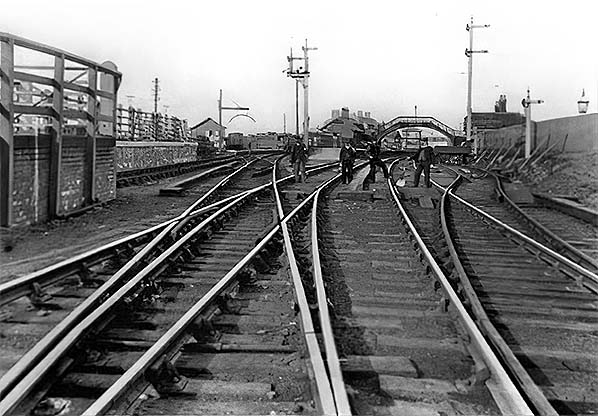
The presence of the second signal box, visible in the background, tells us this view is post 1893 but more precise dating is difficult. The short siding on the right was shown as still present on the 1914 revision of the OS 25" map but had gone by the 1939 revision. This siding has the usual trap point, to protect the main line, and will have been interlocked with the shunt signal to its right. It would have been a locomotive siding but the condition of the railheads suggests it was rarely used. On the left stands the cattle dock and its short siding accessible only by means of a reversal within the goods yard - a not uncommon situation. Just beyond the dock stands Murton's goods loading gauge and further back the small goods shed. The purpose of goods loading gauges was to ensure open or flat wagons were not loaded to a point whereby the loads would strike bridges, tunnels and so on.
Photo from Murton Railway Station History Group  A rather splendid painting of Murton station looking north along the Up (southbound) platform. Detail is superb; note the rail joints, fishplates, rail chairs etc. The second signal box is depicted so the scene represents post 1893 but not too long afterwards due to the Edwardian clothing. The familiar style of the NER footbridge, which was Bridge No. 56, is captured well. The people on the platforms appear to be mainly either off on a shopping trip or away on holiday. The boy with his back to the artist is wearing what looks like Sea Cadets uniform although the shade of blue is rather light. The building with clipped gable on the right was a waiting room and Gentlemen's toilet, from the roof of which a pigeon watches the proceedings. On the platform the station cat is keeping as very careful eye on the artist as if to say "Do you have a platform ticket"?
Painting by Joe McGinn 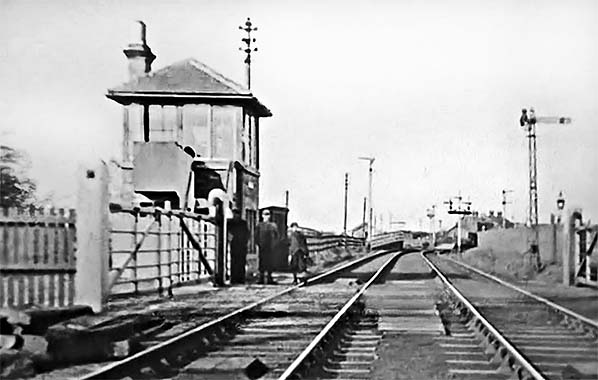 Murton Crossing looking north with the station in the right background, about 1910. The gates are closed to the road yet all signals are at Danger, suggesting the scene was deliberately posed. It is unlikely a train has been halted at the signal protecting the crossing, behind the camera. The signal box, described elsewhere, is in its original external condition with nameplate on the front wall only and with the locking room windows still glazed. Just visible right of centre is the cattle dock, the small goods shed and the goods loading gauge. Among a myriad of wooden-post signals is one on a lattice post, right. This particular signal would in due course receive a wooden and rather lofty post, probably for sighting reasons, and would ultimately be a steel post signal with Home and Distant arms. The oil lamp to the right of the lattice signal was, although not immediately obvious in this view, one of several lining a path which ran behind the fencing to the station and stationmaster's house. On the west side of the level crossing, to the left in this view, was a fairly narrow lane laid with setts which led from the road to the main station building. Due to the presence of the Elvet branch this lane appears to have also been the only road vehicle access to the goods yard. The lane survived the demise of the railway and was partially restored in the early years of the 21st century. Right of centre, the bracket signal carrying three Shunt arms is mildly curious. The arm on the right controlled a short siding behind the platform which is thought to have been a locomotive bay. The centre signal appears to control 'wrong line' through the station while the left hand arm would have controlled a crossover giving access, via a reversal, to the Elvet branch or its associated siding. If this supposition is correct, then quite why such a facility was provided remains open to question.
Photo from John Mann collection old1.jpg) A Worsdell Class G5 0-4-4T, originally North Eastern Railway Class O, arrives at Murton with a Sunderland - Pittington train. The crew has just taken the token from the signalman. The period is immediately after Nationalisation in 1948, this being determinable by the locomotive's livery. She carries 'L.N.E.R' on her tanks but has a British Railways number on her bufferbeam. Unfortunately all we can see of the five digit number is '6725', the fifth digit being obscured by the buffer. Several of the batch numbered 67250 - 67259 were shedded at Sunderland in the late 1940s. The British Railways numbers were simply the numbers from the LNER 1946 Renumbering Scheme preceded by '6'. There are ample photographs of the G5 class wearing the several variations of interim BR liveries available online. Note the lamp post, right of centre, carries a 'lamp tablet'. These announced the station name and were a forerunner of the famous BR 'totem' signs which Murton was never to receive. A Worsdell Class G5 0-4-4T, originally North Eastern Railway Class O, arrives at Murton with a Sunderland - Pittington train. The crew has just taken the token from the signalman. The period is immediately after Nationalisation in 1948, this being determinable by the locomotive's livery. She carries 'L.N.E.R' on her tanks but has a British Railways number on her bufferbeam. Unfortunately all we can see of the five digit number is '6725', the fifth digit being obscured by the buffer. Several of the batch numbered 67250 - 67259 were shedded at Sunderland in the late 1940s. The British Railways numbers were simply the numbers from the LNER 1946 Renumbering Scheme preceded by '6'. There are ample photographs of the G5 class wearing the several variations of interim BR liveries available online. Note the lamp post, right of centre, carries a 'lamp tablet'. These announced the station name and were a forerunner of the famous BR 'totem' signs which Murton was never to receive.Photo from John Mann collection 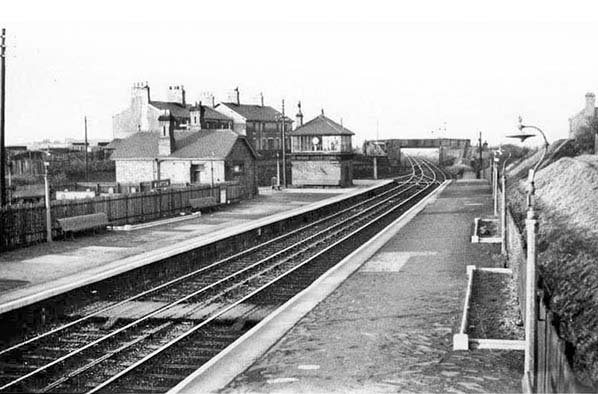
This undated view probably dates from around the time of Nationalisation when, of course, the station was still open to passengers. Although the general ambience is one of drabness the station was nevertheless quite well maintained and by this time electric lighting had been installed. Apart from the not exactly 'shouty' running-in boards, one of which can be seen to the left, numerous lamp tablets can also be, just, discerned. Beneath the bridge a crossover is visible. Sunderland to Durham/Pittington trains would take this crossover before branching off westwards. Beyond the bridge the climb up to Seaton Bank top, about two miles distant, is evident
Photo from Murton Railway Station History Group 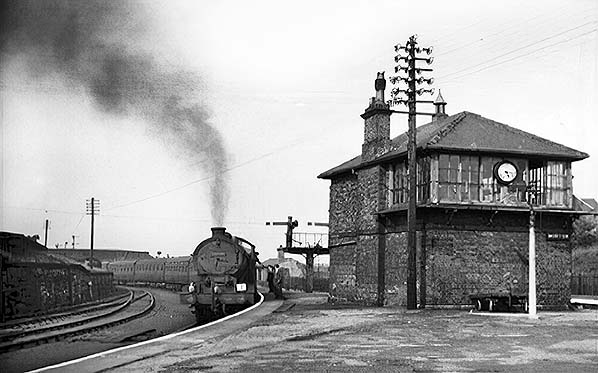
What would appear to be a Class J39 0-6-0 takes the Durham Elvet branch as its crew receive the single line token from the signalman. The train is Empty Coaching Stock and will be returning to Elvet to collect passengers who had attended a Durham Miners' Gala. These trains ran one day per year, usually in July and there were several of them running from various locations in County Durham. Siding capacity at Elvet would have been inadequate for stabling all these trains so some would have to be stabled elsewhere during the day. The clock tells us it was 5.17PM. The name on the signal box states simply 'Murton' and the alternative name for both the 'box and station, 'Murton Junction', appears to have only ever been unofficial although it may have appeared on the diagram inside the 'box. The locomotive's number is illegible but manipulation of the image does reveal it is carrying a shedplate on its smokebox door. From this we can date the photograph to a July between 1950 and 1953 which is quite broad but does provide us with a period. See the second, closer, view of this train below.
Photo from Murton Railway Station History Group
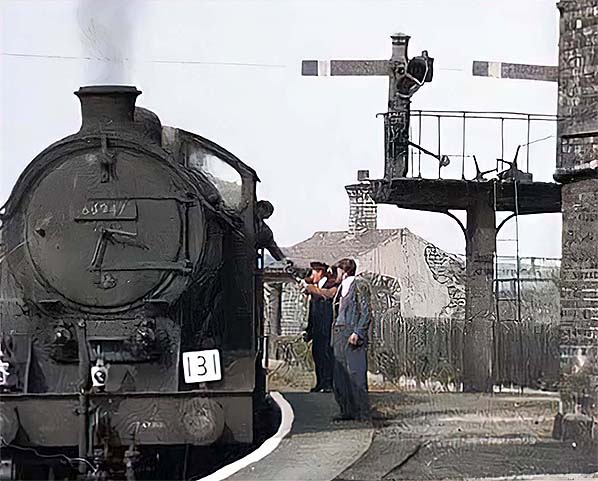
The closer view of the locomotive in the previous image. Even in this view the number of the locomotive is unclear; possibly it was No. 64947 which was a Heaton locomotive at this time and was probably working a South Shields or Heworth Miners Gala Special. The number 131 was from a system used to identify special trains.
Photo from Murton Railway Station History Group 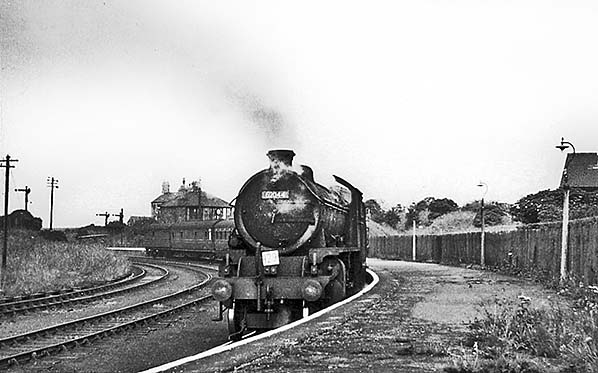 Class K1 2-6-0 No. 62044 takes the Durham Elvet branch through the somewhat rustic platform at Murton with a Durham Miners' Gala special. One record exists of No. 62044 working to Elvet with one of these trains on 27 July 1951, originating at Hutton le Hole (near Pickering, where there were no collieries). This is thought to be an error and the train is more likely running as empty stock to Hetton le Hole to collect passengers for Durham Elvet. It should be remembered, however, that this was not necessarily the only occasion No. 62044 worked such a train. Note the apparently freshly whitewashed platform edge along with the intact platform lighting; the passenger service to Pittington still being in operation at this time. The number '169' was part of system used to identify special trains not found in published timetables. It would in due course be replaced by the British Railways four-character headcode system. Class K1 was an LNER design but did not begin to enter service until May 1949, after Nationalisation. No. 62044 remained in service until July 1967 and the final class member to be withdrawn was No. 62005 on 30 December 1967, which then entered preservation. She sometimes wears LNER green livery which none of the class ever carried in revenue service.
Photo from Murton Railway Station History Group 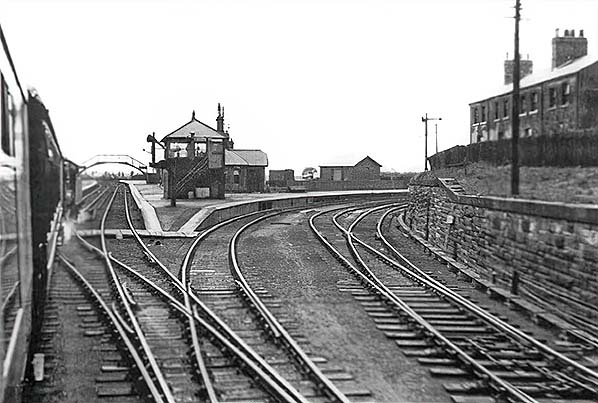
Another south facing view, from a southbound main line train, presumably when the main line part of the station was still open. The railway cottages can be seen on the right. There is a structure, like a flue, on the side of the signal box and which was not present in later photographs. At centre background two, possibly three, vans are visible in the goods yard to the left of the goods shed. Murton closed to goods, and therefore to all traffic, on 13 June 1960. Photo from Murton Railway Station History Group 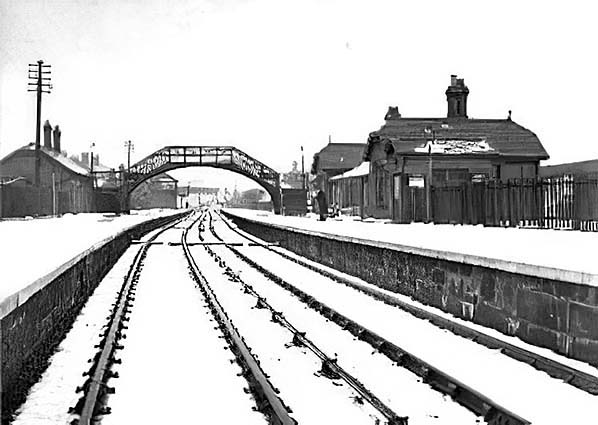 This north facing wintry scene is undated but possibly taken shortly before closure to passengers. The platforms by this time were electrically lit and the light fittings are known to have been removed soon after closure. The footbridge was to the familiar North Eastern Railway style but were manufactured by contractors. As of 2023 a number of these footbridges remain in use and further down the line from Murton another survives at Ryhope, straddling what is now a footpath. This north facing wintry scene is undated but possibly taken shortly before closure to passengers. The platforms by this time were electrically lit and the light fittings are known to have been removed soon after closure. The footbridge was to the familiar North Eastern Railway style but were manufactured by contractors. As of 2023 a number of these footbridges remain in use and further down the line from Murton another survives at Ryhope, straddling what is now a footpath.Photo from Murton Railway Station History Group 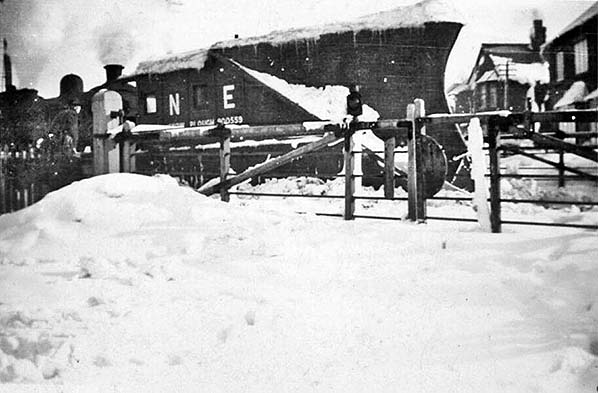
With just a hint of snow present, snowplough No. 900559 is propelled over Murton Crossing, just south of the station. This is a 'drift' type plough with wooden superstructure and a rear verandah, built on the frame of a redundant locomotive tender. The North Eastern Railway built twenty-four of these ploughs, the first twenty having wooden superstructures and the final four, steel. The plough seen here began life in November 1888 as No. 82505 in the wagon series, becoming No. 3 in a dedicated number series in 1908. In 1938 the LNER decided to create a new number series for its departmental stock with No. 3 becoming No. 900559. Therefore 1938 is the earliest possible date for this photograph and indeed it could have been postwar if not very early in the British Railways era, given that anything other than official photographs were rare during WWII. The rather dilapidated level crossing gates may also suggest postwar. British Railways, incidentally, continued using the 900xxx number series for many years and would later prefix the numbers with 'DE'. The initials 'N E' can cause confusion. The North Eastern Railway had used the initials 'N E R' but in 1911 changed to 'N E' for non passenger stock and the LNER continued with it, making its use more widespread during WWII in conjunction with the black locomotive livery applied during the war. The 'N E' initials measured 12" x 18" until 1937 when a smaller size was introduced but it is difficult to judge the size of the letters on view here. It should be remembered that departmental stock was never high up the priority list, vehicle numbers excepted, for such alterations and indeed No. 900559 is known to have worn its LNER livery after Nationalisation. The photograph tells only part of the story. There would have been two locomotives coupled back to back and another plough at the other end. Plough No. 900559 usually worked with No. 900557, which began life as No. 1, both being based at Annfield Plain until this shed closed in 1940, thereafter being based at Gateshead. The allocation was painted on the side of the ploughs but in this view it is annoyingly obscured by the level crossing gate. No. 900559 is thought to have been withdrawn in 1955. Two of these NER ploughs have survived into preservation; No. 12 (DE 900556) and No. 18 (DE 900572). As of 2023 Network Rail still have a number of drift ploughs but to more modern designs. Back at Murton Crossing, this view faces east, the two houses partly visible at extreme right still stand today. Just beyond these houses is the turning into what is now Broadoaks, a modern housing development.
Photo from John Mann collection 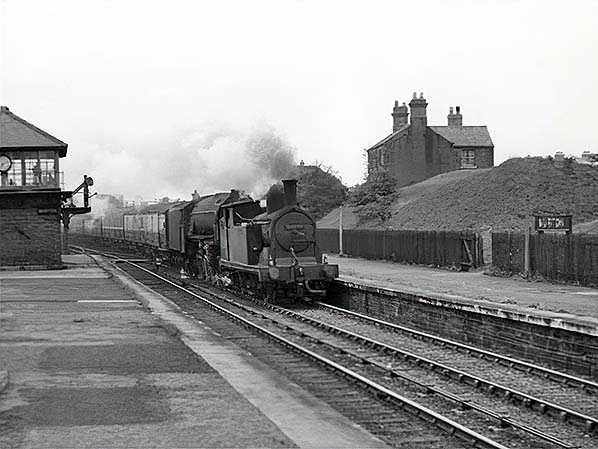 A class G5 0-4-4T carrying express passenger lamps was not a common sight but here we see one passing Murton piloting what appears to be a Peppercorn Class A2 Pacific. The train, or what can be seen of it, is wearing the early British Railways crimson and cream livery. Probably the train had been diverted onto this route, this being known to happen when the Durham Coast line was closed for engineering work or some other disruption. The G5 was likely acting as pilot to assist the train over the long and steep Seaton Bank, being detached at West Hartlepool before piloting another train north over Hesleden Bank. On the right a running-in board still stands but the platform lighting has been removed which tells us the station had closed to passengers by the time this photograph was taken. Class G5 began life as North Eastern Railway Class O and were purposeful, yet somewhat fussy little machines of which several became a common sight working Push & Pull trains. The final example was withdrawn in 1958, giving a date window of 1953 - 1958 for this photograph although the train wearing carmine and cream livery might suggest a little earlier than 1958. No G5 avoided the scrapyard but at the time of writing a 'new build' was under construction. Class A2 fared better with one, BR No. 60532 'Blue Peter' surviving into preservation.
Photo from Murton Railway Station History Group 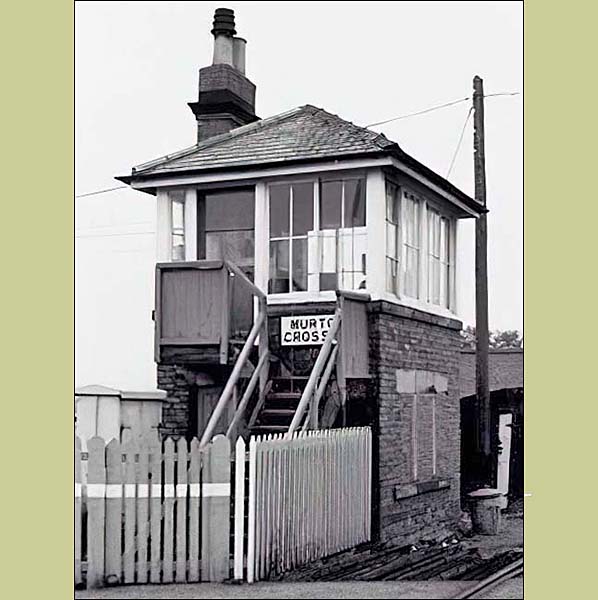
Murton Crossing signal box seen from the level crossing and facing due north. Originally this 'box had a nameboard on the front, facing onto the track but this was later replaced by the board seen here at the top of the steps. Another similar board was fixed to the north end of the 'box. Dating from 1893, Murton Crossing had a Stevens 8-lever frame which for reasons unknown was replaced like-for-like in 1911. A gate box until 9 February 1972, it then became a Block Post while retaining the same 8-lever frame. This situation prevailed until 29 January 1984 when the 'box was fitted with an IFS (Individual Function Switch) panel; this replaced the manual levers with electrical switches and this is the reason for the presence of the electrical equipment cabinets (there were two) one of which is seen here on the left. This splash of modernisation was not to last as the 'box was closed on 13 May 1984. The date 9 February 1972 is significant as from that date as One Train Working was introduced between Murton Crossing and South Hetton Colliery (by this time part of Hawthorn Combined Mine). In addition, on and from 29 January 1984 the line from Ryhope Grange Junction to South Hetton Colliery (Hawthorn CM) was singled with One Train Working introduced. These changes are probably indicative of the fall in coal traffic from the 1970s onwards. More information about what became Hawthorn Combined Mine can be found at the Durham Mining Museum website.
Photo from Murton Railway Station History Group
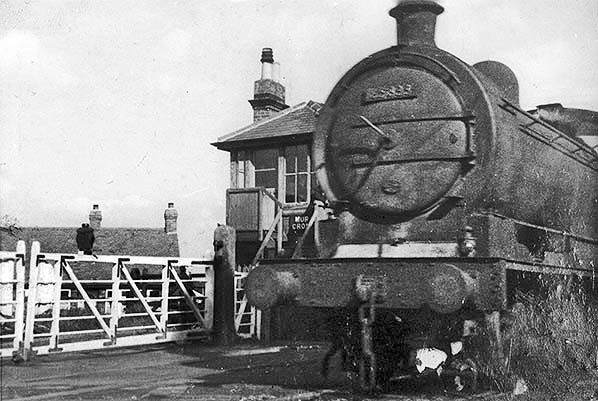 Class J27 0-6-0 No. 65833 trundles south over Murton Crossing. The single lamp on her bufferbeam signifies a Class K goods working so she may have just emerged from Murton goods yard which remained open until June 1960. The houses in the left background have had new windows fitted and we know from other photographs that this occurred sometime in the 1950s. These and the style of the signal box nameboard are the only clues we have to the date of this photograph. Unfortunately the locomotive's shedplate is unreadable but nevertheless she spent all of her BR career at sheds in the Middlesbrough - Thornaby - Sunderland area. Steam clung on fairly late in this part of the country and No. 65833, dating from 1909, did not bow out until May 1967 being withdrawn from Sunderland shed.
Photo from Murton Railway Station History Group 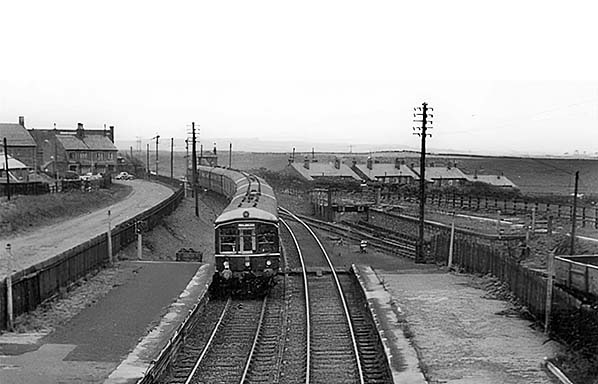 A pair of 4-car Derby Lightweight DMUs pass through Murton heading south. Only five of these 4-car 79xxx Derby Lightweights were built and their operations in normal service were confined to the North East. They were delivered to South Gosforth in September 1955 and by 1957 all Driving Motor cars had received 'whiskers' on the panels below the windscreens, therefore we can date this view to that two year window. What the train was doing passing through Murton southbound can only be speculated upon. The destination blind is unreadable although being at the rear whatever it displayed was probably irrelevant. It may have been a crew training run as some training is known to have been undertaken on this line. The train is approaching Murton Crossing and has the 'proceed' aspect by the lower quadrant signal, this signal being described further elsewhere. The road on the left gave access to the station and apparently was officially a footpath. On the now-disused station platforms the lighting has been removed from its stanchions; this was done very quickly after closure and probably because the light fittings were required for use elsewhere. Right of centre can be seen the cattle dock, the short siding serving it being only accessible from within the goods yard. A mineral wagon can be seen at extreme right. The fencing further back on the right marked, roughly, the course of the curve which once existed, way back in rope haulage days, giving direct access to the Elvet branch from the south. It turned westwards to join the Elvet branch on a very sharp curve. A pair of 4-car Derby Lightweight DMUs pass through Murton heading south. Only five of these 4-car 79xxx Derby Lightweights were built and their operations in normal service were confined to the North East. They were delivered to South Gosforth in September 1955 and by 1957 all Driving Motor cars had received 'whiskers' on the panels below the windscreens, therefore we can date this view to that two year window. What the train was doing passing through Murton southbound can only be speculated upon. The destination blind is unreadable although being at the rear whatever it displayed was probably irrelevant. It may have been a crew training run as some training is known to have been undertaken on this line. The train is approaching Murton Crossing and has the 'proceed' aspect by the lower quadrant signal, this signal being described further elsewhere. The road on the left gave access to the station and apparently was officially a footpath. On the now-disused station platforms the lighting has been removed from its stanchions; this was done very quickly after closure and probably because the light fittings were required for use elsewhere. Right of centre can be seen the cattle dock, the short siding serving it being only accessible from within the goods yard. A mineral wagon can be seen at extreme right. The fencing further back on the right marked, roughly, the course of the curve which once existed, way back in rope haulage days, giving direct access to the Elvet branch from the south. It turned westwards to join the Elvet branch on a very sharp curve.Photo from Murton Railway Station History Group
|

 Home Page
Home Page